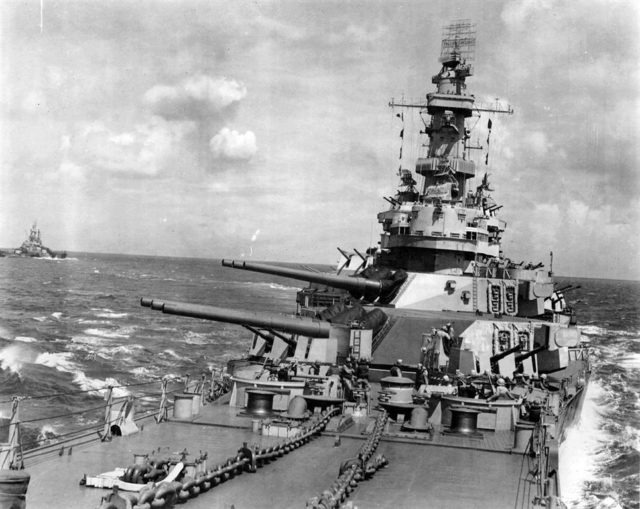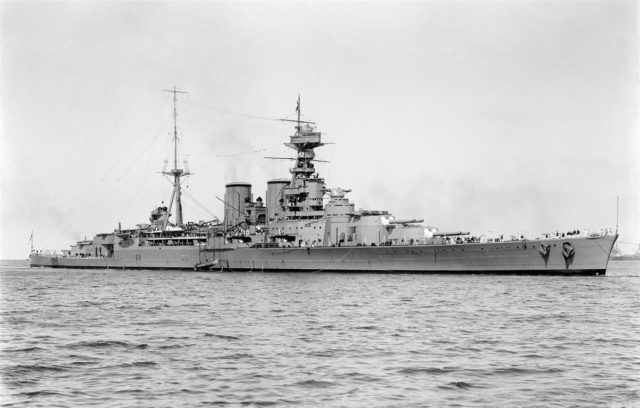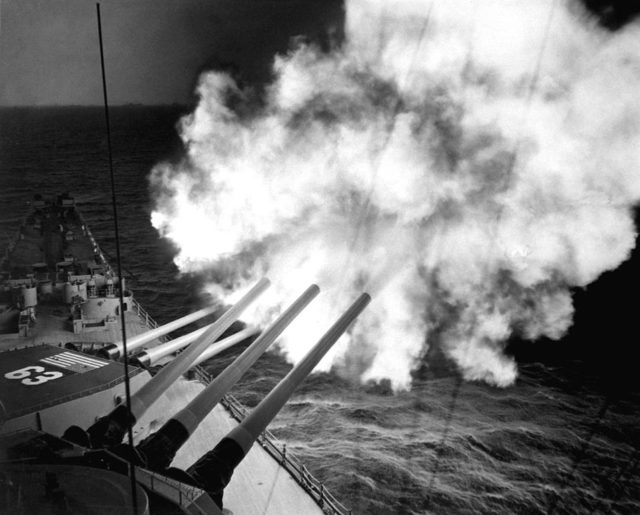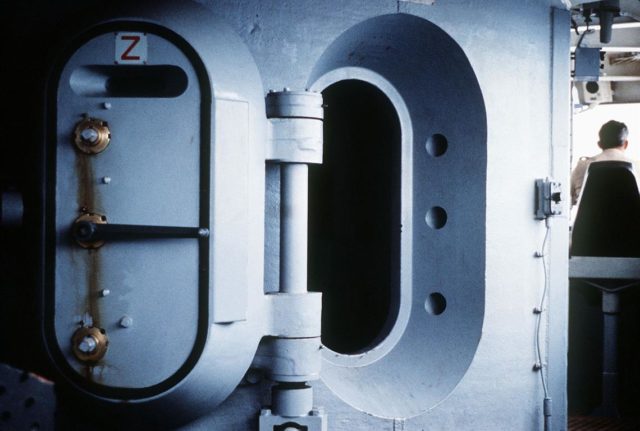On the surface, history can appear a rigid, unmoving thing. That once something is historically established, it remains that way forever. However, the truth of the matter is that history is largely pliable. The more blurry facts can be easily be bent to support a particular view. A small, but popular opinion is that the Iowa class battleships of the US Navy could be considered battlecruisers. What are battlecruisers and why would anybody think the Iowa class is like them? I will look at the rationale for this opinion and refine the lines that separate battleship from battlecruiser. With a bit of digging, we will find out whether we need to refer to these dreadnaughts as the Iowa class battlecruisers from now on.

Why would the Iowa class be considered Battlecruisers?
1) Their armor was unable to withstand the firepower of their own guns.
2) They sacrificed armor to achieve higher speeds.
It is true that these ships were exceedingly fast and that armor wise they were a departure from traditional practice. However, is this enough to brand them as battlecruisers? To compare, let us examine the concept behind battlecruisers and see what made them different from battleships.
What Are Battlecruisers?

Battlecruisers were a short-lived vessel only used during the first half of the 20th century. They were conceived on the idea that faster capital ships would be both more effective and more flexible than the slower battleships in combat. Battlecruisers were designed to fulfill the following criteria:
- Use their superior speed to chase down slower vessels.
- Outgun weaker vessels while being able to outrun more powerful ones.
- Harass enemy shipping lines and disrupt trade.
- Support the main fleet by defending against cruisers.
At first, battlecruisers were fairly effective when deployed in the manner in which they were intended. The Battles of Heligoland Bight and the Falkland Islands were instances of battlecruisers fulfilling their roles and destroying enemy cruisers. However, as the war progressed, battlecruisers became increasingly less useful. Coordinated actions by large fleets ensured that they were only as fast as he slowest vessels involved. In latter engagements like the battle of Jutland, they fared poorly when forced to directly engage the more heavily armored battleships.
To rectify these weaknesses, cruisers became increasingly armored to the point that they were almost battleships. On the other hand, battleships were becoming faster, to the point that newer designs were as fast as battlecruisers. These advances caused the line between battleship and battlecruiser to blur.
Are the Iowa Class actually Battlecruisers?
At first glance the Iowa class vessels were very similar to battlecruisers. They were directly designed to hunt down and destroy weaker ships such as the Kongo Class battleships. They were lightly armored compared to their displacement, especially compared to previous US battleships. However, they also were very different in several important areas. First, lets take a look at some of the arguments listed above.Their armor was unable to withstand the firepower of their own guns

While the Iowa class did have an immunity zone against its own guns, it was smaller than US designers would have preferred. This was largely due to advances in technology. The Iowa class was originally designed to withstand the US Mark 5 2240lb AP shell. The designers were able to create reasonable zone of immunity from this shell. However, after the designs were largely finished, the Mark 8 2700 “Super Heavy” shell was introduced. This shell offered much greater capability and was thus harder to protect against. When combined with the 16″/50 cannon, the Iowa class had what could be the best naval gun put into service. At long ranges, the cannon was almost equal to the Yamato’s larger 18″ guns. Armoring against this shell would have required a much greater displacement than what the Iowa class offered.
As to the idea that battleships must be armored to resist their own guns, As best as I could tell, this myth arose from the practices of naval designers when creating armor schemes for their warships. Not having access to foreign weapons, they used their own weapons. Thus, they designed their own ships to resist their own guns. It was simply a matter of convenience.
They sacrificed armor to achieve higher speeds

While the Iowa class might not have been armored as much as US designers would have preferred, it was still very much a protected battleship. It was designed to engage battleships in direct combat, survive whatever shells came their way, and emerge the victor. This is a stark contrast to the types of combat that typical battlecruisers were to engage in. At the very least, one could make the argument that the Iowa class was a faster model of a preceding battleship.
Conclusions: Battleship or Battlecruiser
Based on design and the intentions of designers, the Iowa class were battleships. They were designed like battleships, they were armored like battleships, and they could certainly fight other battleships. However, I would go so far as to argue that their design was unique. Perhaps a blend of ideas behind both battleships and battlecruisers to a degree.As battlecruisers gained armor and battleships gained speed, the line separating the vessels blurred. The Iowa class exists in that blurry area. It was a battleship that incorporated some of the doctrine that inspired battlecruisers. Unlike battlecruisers that were designed to chase down and destroy enemy cruisers, the Iowa class was designed with bigger prey in mind. They were designed to hunt down enemy battleships and other large vessels. Unlike battleships, that got faster through the advancement of engine technology, the Iowa class was designed to be fast. They were the only class of battleship that could be considered true fast battleships in that speed was a main goal in their design.
In many ways, the Iowa class took the best features of both battleships and battlecruisers to create a specialized class. The real question is what the Iowa class would have inspired had the age of dreadnaughts not ended when it did. How fast would have subsequent battleships become? Unfortunately, we will never know. Although the proposed Montana Class Battleships would have given some ideas...


I love your tales of the great ships of the second war. My son is a 2nd class petty officer on the Ticonderoga class ship the USS Leyte Gulf. He is a sonar technician, but he also is part of the crisis response team and security as well. So when coming into port, he is often on the deck, fully armed with M-16 and Pistol, guarding while they dock. He told me a story that when they were at fleet week, in Boston, at anchor, a small boat with a 70 year old couple motored along side to take pictures. Now the rule is that of fifty feet being the closest that they allow any water traffic to come, and this of course creates a huge dilemma for those standing watch. What do you do? Imagine the nightmare if they did the proper and called for thing and shot them out of the water. My son said that they were screaming and trying to wave the couple off, but they just smiled and waved back. The chief on the deck told the guy manning the machine gun, I think a fifty caliber, to chamber a round, and be ready to fire. Of course, nothing bad happened, or we all would have heard about it, but it just goes to show you that sometimes the job of those in the military is not as simple and straight forward as those wearing civilian clothes like myself and most of the public would like to think. Keep on posting these wonderful stories, I learn a lot from them.
ReplyDeleteAny sailor who served on them will tell you they were battleships. :-)
ReplyDeleteThoughtful and comprehensive. Great article.
ReplyDelete